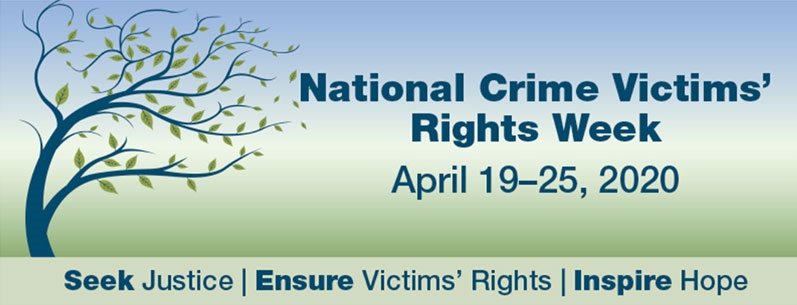National Crime Victims' Rights Week 2020
Honoring Victims’ Rights Week - New Hate Crimes Resources
National Crime Victims’ Rights Week is an annual event highlighting the important voices of crime survivors and the countless service providers and first responders who work tirelessly to support them. NCVRW is also an opportunity to share knowledge and resources with the nation.
To that end, the Department is excited to highlight two reports, funded by the Office of Justice Programs, that give new insight into how often youths and members of the Latino community experience and witness bias-motivated incidents, like bullying or harassment, and hate crimes. The findings can help policymakers, law enforcement, school professionals, and service organizations improve the targeting and content of prevention and intervention programs.
The first study, “Comprehensive Measure of Youth Experiences with Bias Victimization: Findings from the Youth Bias Victimization Questionnaire (YBVQ)” developed a new survey tool to measure youth bias victimization, from bullying to hate crimes. The sample included 854 youth ages 11-21 across three research sites: Boston, Philadelphia and Tennessee.
Youth Bias Victimization Survey
Sample of 854 youths ages 11-21 from the study "Comprehensive Measure of Youth Experiences with Bias Victimization: Findings from the Youth Bias Victimization Questionnaire (YBVQ)"
The most frequent bias victimizations were those targeting someone’s race, ethnicity or skin color. Forty-three percent of the sample personally experienced this kind of victimization in their lifetime, and 83% witnessed such victimization. Bias victimization related to sexual orientation was the second most common, with 28% experiencing victimization and 78% witnessing.
The most common form of victimization that occurred was emotional bullying (76% of incidents), followed by relational bullying (bullying among friends, including exclusion and spreading rumors) (36%), sexual harassment (23%) and threatening assault (22%). In almost 10 percent of incidents the youth was physically assaulted; in almost 7% a robbery occurred, and in 6% property was vandalized.
Another recent study funded by the Department, “Understanding and Measuring Bias Victimization Against Latinos", surveyed 910 adult Latinos in three metropolitan areas – San Diego, Boston, and Houston. Just over half of the participants were immigrants to the U.S. Participants were asked five questions about a broad range of bias events, from harassment and micro-aggression to violent or property crimes.
Over half of the study population had experienced bias events and 28% experienced hate crimes in their lifetime. There were significant differences between men and women on some of the more serious events, like physical assaults and assaults with a weapon, but not on the overall rate. Participants from Boston had a significantly higher lifetime bias victimization rate than those in Houston and significantly higher than both Houston and San Diego on past year bias rates.
Only 18.2% of Latinos experiencing bias crimes sought help from any formal authority (e.g. police, medical providers, victim service providers, attorneys) while 68.1% of victims sought informal help, generally from friends or family.
Bias Victimization Among Adult Latinos
Sample of 910 adult Latinos in three metropolitan areas - San Diego, Boston, and Houston from the study "Understanding and Measuring Bias Victimization Against Latinos"
These reports, along with a searchable database of other hate crimes resources produced or funded by the Department, are available on the Resources page of this website. These tools and resources can help researchers, survivors, educators, advocates, law enforcement and others provide more effective programming, trainings and further research on hate crimes.
To find more information about bullying (OJJDP), NCVRW & victims of crime (OVC), and the funder of these reports (NIJ) visit www.ovc.gov.




